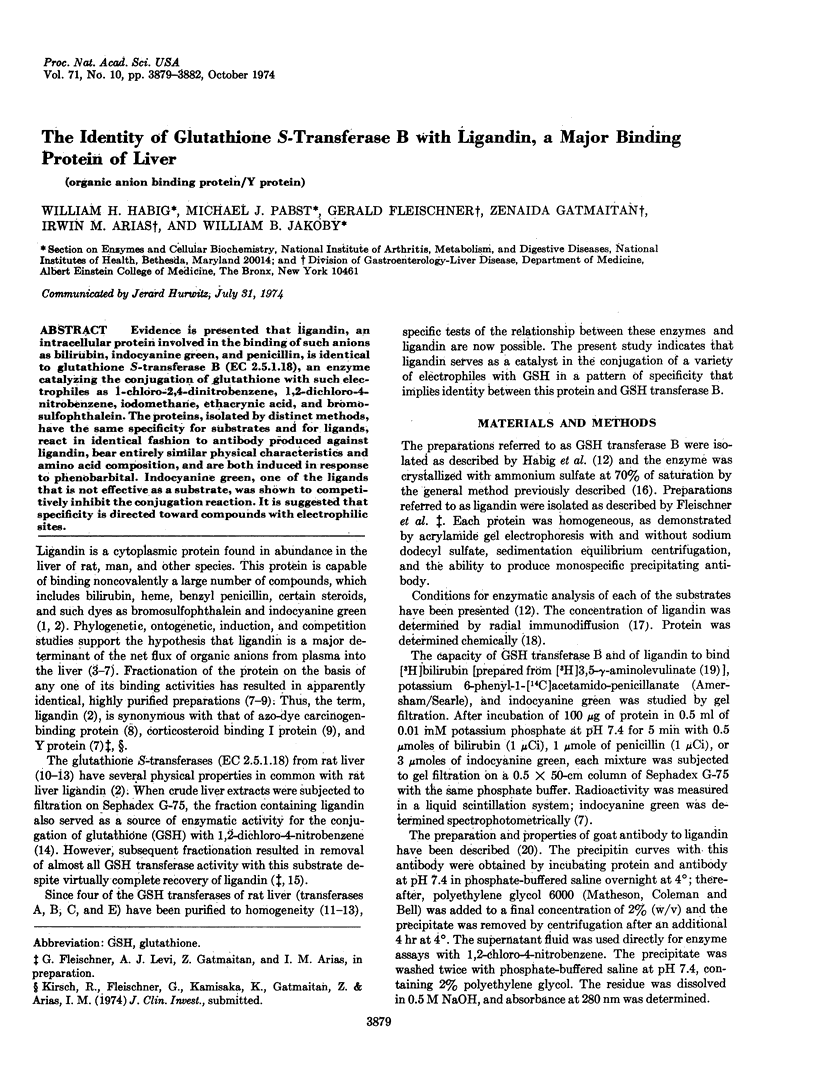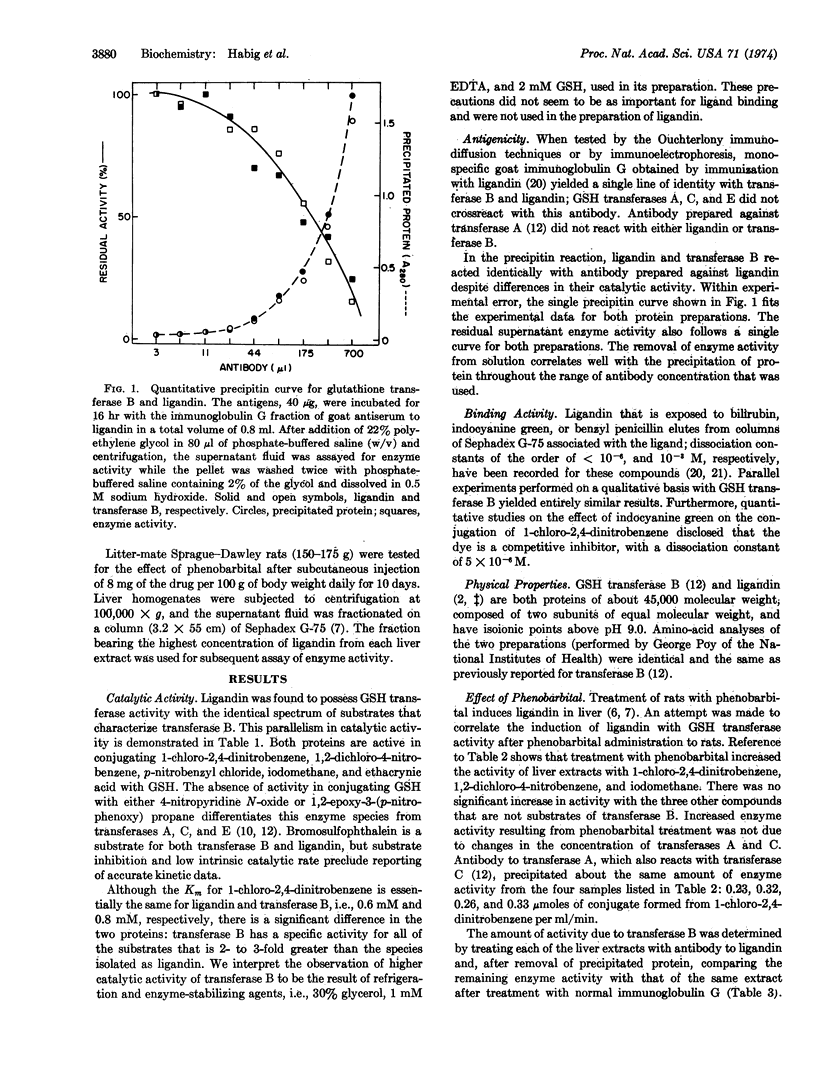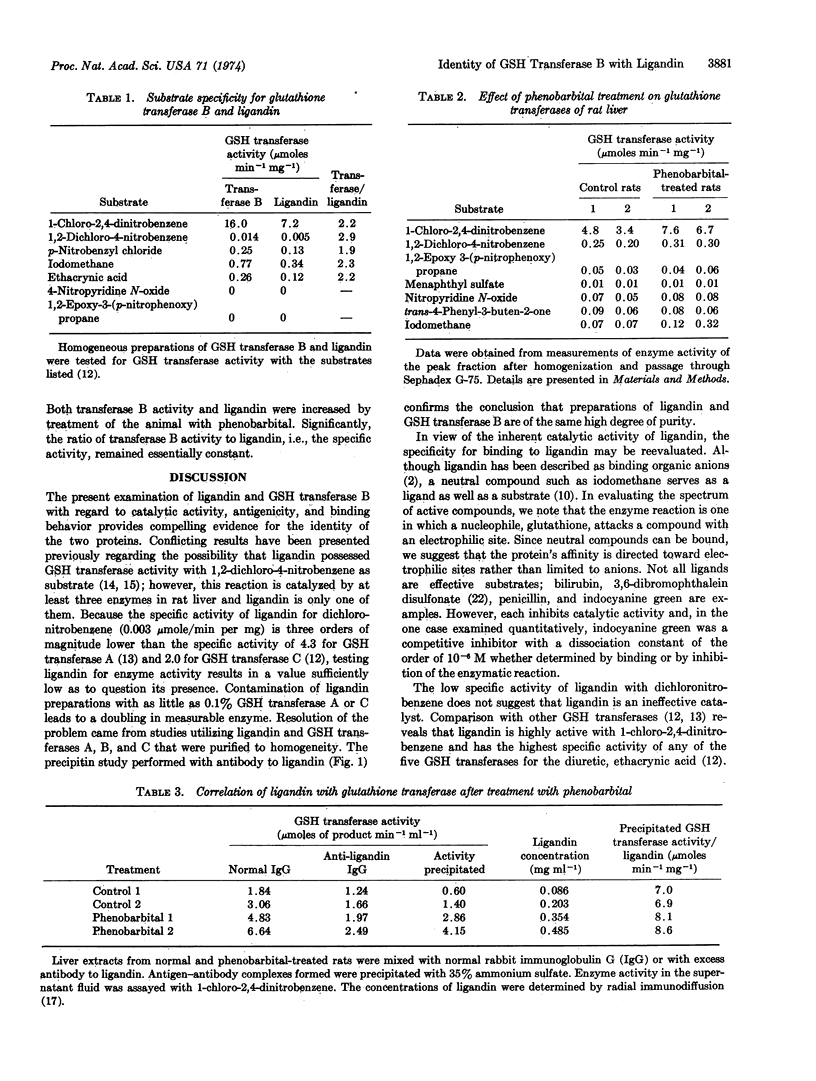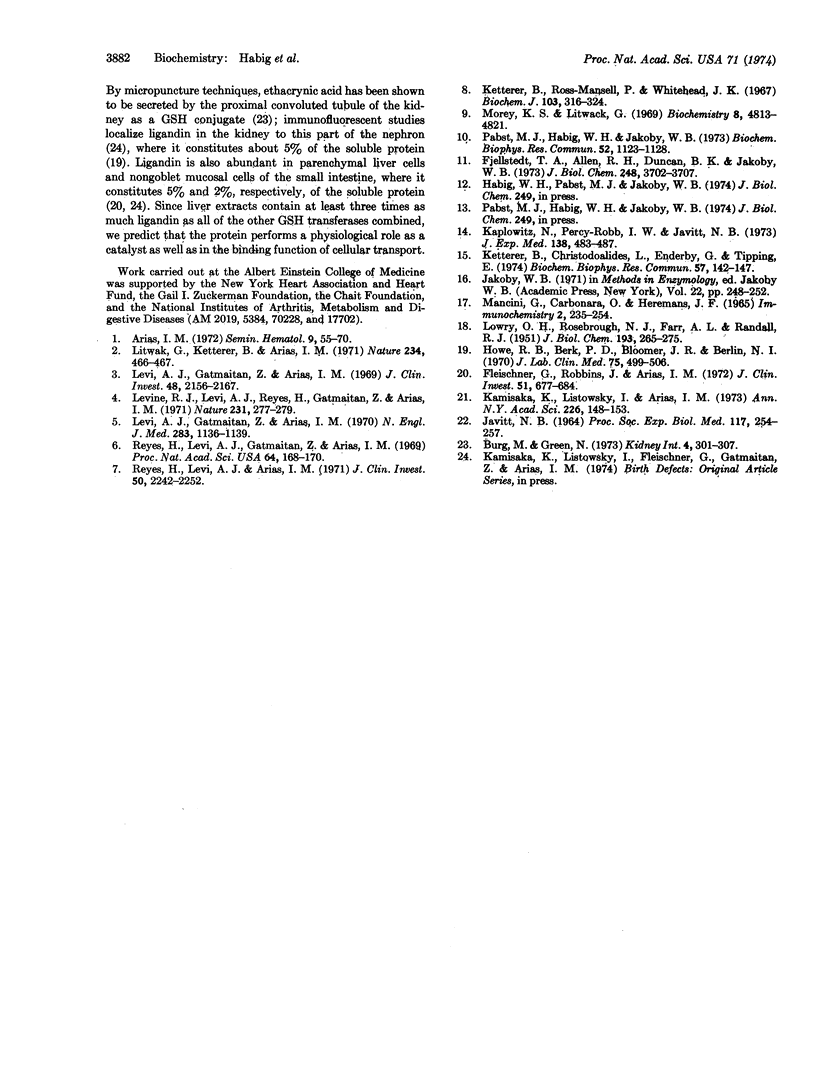Abstract
Evidence is presented that ligandin, an intracellular protein involved in the binding of such anions as bilirubin, indocyanine green, and penicillin, is identical to glutathione S-transferase B (EC 2.5.1.18), an enzyme catalyzing the conjugation of glutathione with such electrophiles as 1-chloro-2,4-dinitrobenzene, 1,2-dichloro-4-nitrobenzene, iodomethane, ethacrynic acid, and bromosulfophthalein. The proteins, isolated by distinct methods, have the same specificity for substrates and for ligands, react in identical fashion to antibody produced against ligandin, bear entirely similar physical characteristics and amino acid composition, and are both induced in response to phenobarbital. Indocyanine green, one of the ligands that is not effective as a substrate, was shown to competitively inhibit the conjugation reaction. It is suggested that specificity is directed toward compounds with electrophilic sites.
Keywords: organic anion binding protein, Y protein
Full text
PDF



Selected References
These references are in PubMed. This may not be the complete list of references from this article.
- Arias I. M. Transfer of bilirubin from blood bile. Semin Hematol. 1972 Jan;9(1):55–70. [PubMed] [Google Scholar]
- Burg M., Green N. Effect of ethacrynic acid on the thick ascending limb of Henle's loop. Kidney Int. 1973 Nov;4(5):301–308. doi: 10.1038/ki.1973.121. [DOI] [PubMed] [Google Scholar]
- Fjellstedt T. A., Allen R. H., Duncan B. K., Jakoby W. B. Enzymatic conjugation of epoxides with glutathione. J Biol Chem. 1973 May 25;248(10):3702–3707. [PubMed] [Google Scholar]
- Fleischner G., Robbins J., Arias I. M. Immunological studies of Y protein. A major cytoplasmic organic anion-binding protein in rat liver. J Clin Invest. 1972 Mar;51(3):677–684. doi: 10.1172/JCI106856. [DOI] [PMC free article] [PubMed] [Google Scholar]
- Howe R. B., Berk P. D., Bloomer J. R., Berlin N. I. Preparation and properties of specifically labeled radiochemically stable 3H-bilirubin. J Lab Clin Med. 1970 Mar;75(3):499–502. [PubMed] [Google Scholar]
- Kamisaka K., Listowsky I., Arias I. M. Circular dichroism studies of Y protein (ligandin), a major organic anion binding protein in liver, kidney, and small intestine. Ann N Y Acad Sci. 1973 Nov 26;226:148–153. doi: 10.1111/j.1749-6632.1973.tb20477.x. [DOI] [PubMed] [Google Scholar]
- Kaplowitz N., Percy-Robb I. W., Javitt N. B. Role of hepatic anion-binding protein in bromsulphthalein conjugation. J Exp Med. 1973 Aug 1;138(2):483–487. doi: 10.1084/jem.138.2.483. [DOI] [PMC free article] [PubMed] [Google Scholar]
- Ketterer B., Christodoulides L., Enderby G., Tipping E. Mercapturic acid biosynthesis: the separate identities of glutathione-S-aryl chloride transferase and ligandin. Biochem Biophys Res Commun. 1974 Mar 15;57(1):142–147. doi: 10.1016/s0006-291x(74)80368-2. [DOI] [PubMed] [Google Scholar]
- Ketterer B., Ross-Mansell P., Whitehead J. K. The isolation of carcinogen-binding protein from livers of rats given 4-dimethylaminoazobenzene. Biochem J. 1967 May;103(2):316–324. doi: 10.1042/bj1030316. [DOI] [PMC free article] [PubMed] [Google Scholar]
- LOWRY O. H., ROSEBROUGH N. J., FARR A. L., RANDALL R. J. Protein measurement with the Folin phenol reagent. J Biol Chem. 1951 Nov;193(1):265–275. [PubMed] [Google Scholar]
- Levi A. J., Gatmaitan Z., Arias I. M. Deficiency of hepatic organic anion-binding protein, impaired organic amnion uptake by liver and "physiologic" jaundice in newborn monkeys. N Engl J Med. 1970 Nov 19;283(21):1136–1139. doi: 10.1056/NEJM197011192832104. [DOI] [PubMed] [Google Scholar]
- Levi A. J., Gatmaitan Z., Arias I. M. Two hepatic cytoplasmic protein fractions, Y and Z, and their possible role in the hepatic uptake of bilirubin, sulfobromophthalein, and other anions. J Clin Invest. 1969 Nov;48(11):2156–2167. doi: 10.1172/JCI106182. [DOI] [PMC free article] [PubMed] [Google Scholar]
- Levine R. I., Reyes H., Levi A. J., Gatmaitan Z., Arias I. M. Phylogenetic study of organic anion transfer from plasma into the liver. Nat New Biol. 1971 Jun 30;231(26):277–279. doi: 10.1038/newbio231277a0. [DOI] [PubMed] [Google Scholar]
- Litwack G., Ketterer B., Arias I. M. Ligandin: a hepatic protein which binds steroids, bilirubin, carcinogens and a number of exogenous organic anions. Nature. 1971 Dec 24;234(5330):466–467. doi: 10.1038/234466a0. [DOI] [PubMed] [Google Scholar]
- Mancini G., Carbonara A. O., Heremans J. F. Immunochemical quantitation of antigens by single radial immunodiffusion. Immunochemistry. 1965 Sep;2(3):235–254. doi: 10.1016/0019-2791(65)90004-2. [DOI] [PubMed] [Google Scholar]
- Morey K. S., Litwack G. Isolation and properties of cortisol metabolite binding proteins of rat liver cytosol. Biochemistry. 1969 Dec;8(12):4813–4821. doi: 10.1021/bi00840a024. [DOI] [PubMed] [Google Scholar]
- Pabst M. J., Habig W. H., Jakoby W. B. Mercapturic acid formation: the several glutathione transferases of rat liver. Biochem Biophys Res Commun. 1973 Jun 19;52(4):1123–1128. doi: 10.1016/0006-291x(73)90616-5. [DOI] [PubMed] [Google Scholar]
- Reyes H., Levi A. J., Gatmaitan Z., Arias I. M. Organic anion-binding protein in rat liver: drug induction and its physiologic consequence. Proc Natl Acad Sci U S A. 1969 Sep;64(1):168–170. doi: 10.1073/pnas.64.1.168. [DOI] [PMC free article] [PubMed] [Google Scholar]
- Reyes H., Levi A. J., Gatmaitan Z., Arias I. M. Studies of Y and Z, two hepatic cytoplasmic organic anion-binding proteins: effect of drugs, chemicals, hormones, and cholestasis. J Clin Invest. 1971 Nov;50(11):2242–2252. doi: 10.1172/JCI106721. [DOI] [PMC free article] [PubMed] [Google Scholar]


